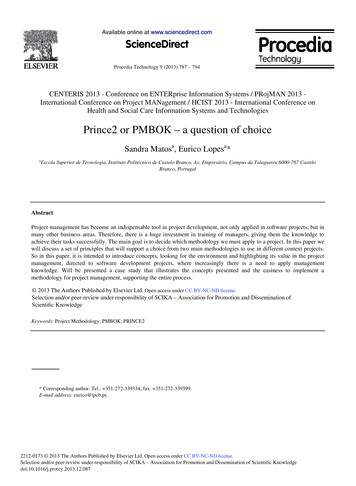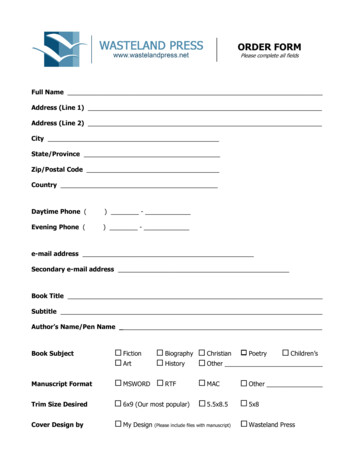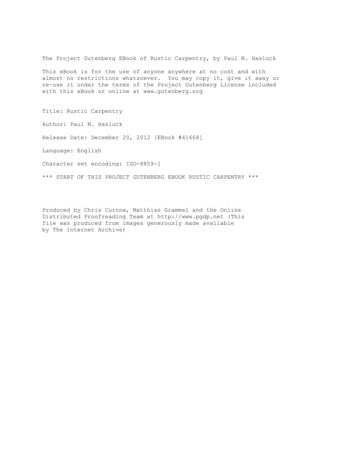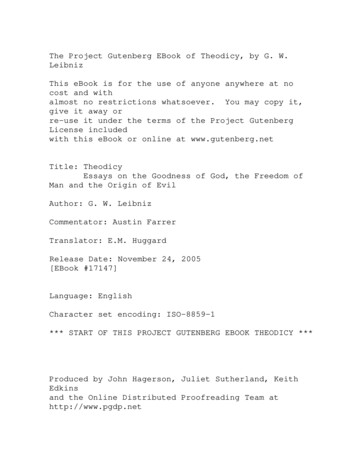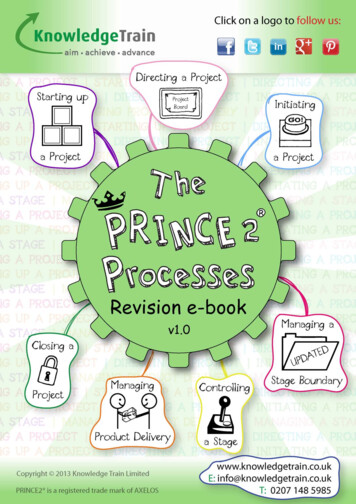
Transcription
IntroductionPRINCE2, the world’s most popular projectmanagement framework is composed of 4integrated elements. These are Tailoring the framework to suit the needs of theproject environmentProcesses – who does what and whenThemes – aspects which need to be continuouslyaddressed throughout the projectPrinciples – building blocks upon which thethemes and processes have been basedIn this e-book we’re going to focus on the 7 PRINCE2processes. In particular, we’re going to focus onthose elements which most frequently are examinedon the PRINCE2 Foundation exam.In essence, this e-book is a PRINCE2 Foundationexam revision tool. It’s not designed as an in depthguide to PRINCE2. For that, it’s much better to readthe official manual – Managing Successful Projectswith PRINCE2 .We believe that if you use this e-book to study forthe PRINCE2 Foundation exam, then your chancesof passing will be much greater. Words which havebeen italicised and/or bolded and their associateddefinitions in this e-book are ones which you needto familiarize yourself before the exam.This e-book is one of a series of three, each oneexploring one of the integrated elements. Theothers in the series are the PRINCE2 principles andthe PRINCE2 themes.In this e-book, any quoted text is ManagingSuccessful Projects with PRINCE2 2009 Edition.Copyright AXELOS Limited 2009. Material isreproduced under licence from AXELOS.2
Starting Up a ProjectPurpose: to answer the question “do we have aviable and worthwhile project?”The process “is as much about preventing poorlyconceived projects from ever being initiated as itis about approving the initiation of viable projects.The aim is to do the minimum necessary in order todecide whether it is worthwhile to even initiate theproject.”The trigger for the project is a project mandate (atrigger is an event or decision which “triggers” oneof the 7 processes).The project mandate “should provide the termsof reference for the project and should containsufficient information to identify at least theprospective Executive of the Project Board.”Before the project is initiated key roles andresponsibilities for doing the work during initiationmust be resourced and allocated – i.e. who is goingto write the Business Case or the Project Plan.Objectives: “Individuals are appointed who willundertake the work required in projectinitiation and/or will take significant projectmanagement roles in the project;The work required for project initiation isplanned (documented in a Stage Plan);Time is not wasted initiating a project basedon unsound assumptions regarding theproject’s scope, timescales, acceptancecriteria and constraints.”The Executive is responsible for creating the outlineBusiness Case, which is used to “understand howthe project will contribute toward corporate and/orprogramme objectives”; and “understand how theproject will be funded.” The Executive is responsiblefor securing the funding for the project.The 2 main outputs are: Project Brief - ensures that the project hasa “commonly understood and well-definedstart point“3
Initiation Stage Plan - when making a planfor the initiation stage (the first stage of theproject) the Project Manager must reviewthe Lessons Log for lessons relating to theproject controls to be used during initiation.This process is a pre-project process.Directing a ProjectPurpose: “to enable the Project Board to beaccountable for the project’s success by makingkey decisions and exercising overall control whiledelegating day-to-day management of the project tothe Project Manager“This process starts after the Starting up a Projectprocess has completed and is triggered by a requestto initiate the project.The Project Board is responsible for assuring thatthere is continued business justification. Thisprocess “provides a mechanism for the ProjectBoard to achieve such assurance without beingoverburdened by project activity”. The Project Boardalso acts as a communication channel or interfacewith corporate/programme management.performance of the current stage and approves thenext Stage Plan (or Exception Plan) if the businessjustification still exists, and commits the requiredresources. It also reviews Lessons Reports andagrees on who should receive them.The Project Board also approves ProductDescriptions which involves: the Senior Userbecause they (the users) will use the products;the Executive because they will fund the products’creation; and the Senior Supplier because they willdeliver the products.4. Give ad-hoc direction – it reviews Highlight, Issueand Exception Reports from the Project Managerand takes decisions about Project Issues, risks andchanges.5. Authorize project closure - it reviews andapproves the End Project Report (and LessonsReport) if it is satisfied that there is nothing morethe project to do.The Executive is the decision maker on the projectand “the Project Manager should defer to theExecutive” if the Project Board cannot agree i.e. theProject Board is NOT a democracy.The Project Board is responsible for ProjectAssurance, but the Project Board members mayappoint persons to perform Project Assurance ontheir behalf e.g. to undertake some of the reviewingand assessing actions such as reviewing Stage Plans.The Project Board performs 5 activities:1. Authorize initiation - ensures that the projectinvestment is worthwhile and then notifiescorporate or programme management andother interested parties. The CommunicationManagement Strategy will include any informationabout the stakeholders’ information requirements.2. Authorize the project – approves the ProjectInitiation Documentation (PID) if it is satisfied thefirm foundations for the project are in place3. Authorize a Stage or Exception Plan – reviews the4
5
Initiating a ProjectPurpose: “to establish solid foundations for theproject, enabling the organization to understand thework that needs to be done to deliver the project’sproducts before committing to a significant spend”.The objective is to ensure there’s a commonunderstanding of: why we’re doing the project;timescales and costs; scope; major products;expected benefits; risks; quality requirements andstandards; how baseline products will be controlled;the communication needs of stakeholders. Theabove information is contained within the ProjectInitiation Documentation (PID) which also describeshow “the Corporate (or programme’s) projectmanagement method will be tailored to suit theproject.”The PID contains the following: Project Plan - defines what the project mustdeliver and ensures an understanding of howthe objectives will be achieved, before theProject Board commits the resources (money,people, etc.). Detailed Business Case - (derived from the outline Business Case) containing details oftimescales, costs, benefits and risks.Communication Management Strategy describes the information needs of stakeholderse.g. those who need to be informed of newrisks, or that the project is about to close.Risk Management Strategy – describes theproject’s general approach to risk management.Quality Management Strategy – describes howquality requirements and standards will be met.Configuration Management Strategy –describes how changes and issues will bemanaged and how baseline products will beversion-controlled.Elements from the Project Brief (the projectdefinition and project approach) are alsoincluded in the PID.Project controls – describes how the project willbe controlled e.g. dates of stage boundaries andreporting and escalation requirements.Initial Configuration Item Records are created forbaseline management products already created andany pre-existing project documentation that needsto be controlled, e.g. feasibility study, request forproposal etc.6
A Benefits Review Plan is created which plans forthe measurement of benefits during and after theproject. It is updated at project end, and is notarchived because it remains an active documentafter project closure and is owned by corporate/programme management.Managing a Stage BoundaryPurpose: “to enable the Project Board to beprovided with sufficient information by the ProjectManager so it can review the success of thecurrent stage, approve the next Stage Plan, reviewthe updated Project Plan, and confirm continuedbusiness justification and acceptability of the risks.”Towards the end of every stage (except the finalstage) the Project Manager performs this processto start planning for the next stage. This processoverlaps with the other processes active at the time.The ‘manage by exception’ principle means that theProject Board only meets with the Project Managerat the end of a stage (known as an End StageAssessment). At this point the Project Managermust provide the necessary information for theProject Board to make an informed decision aboutcontinuing with the project.In this process the Project Manager updates thevarious products including the project managementteam required for the next stage; the 4 managementstrategies; and the Business Case and Project Plan.The Project Plan is updated by incorporating theactual progress from the stage just finishing, andrevised time and cost forecasts for the remainder ofthe project.As the Executive is responsible for the BusinessCase, the Project Manager should consult withthe Executive when reviewing and updating theBusiness Case in preparation for Project Boardapproval and assess the project’s risks using the RiskRegister to ascertain the aggregated risk exposurefor the project and identify the current key risks thataffect the Business Case.The Benefits Review Plan is reviewed to check theresults of any benefits reviews undertaken duringthe stage.7
An Exception Plan is created when the ProjectBoard asks the Project Manager to create a newplan, based on recommendations made in anException Report. In this situation, instead ofcreating the next Stage Plan, the Project Manageruses the process to create an Exception Plan. Theother 3 activities of the process remain the samehowever, namely: Update the Project Plan, Updatethe Business Case, and Report stage end.reporting and problem handling arrangements mustbe agreed, and the Risk Register updated to includeany new risks.Once the work is under way, the Team Managersends regular Checkpoint Reports (a time-drivencontrol) to the Project Manager. The ProjectManager collects and reviews progress informationfrom these reports and assesses the estimated timeand effort to complete any remaining work.A Lessons Report may also be created in thisprocess. The Quality Management Strategy mightneed to be revised, based on quality activitiesduring the stage just finishing.The Project Manager sends regular HighlightReports (a time-driven control) to the Project Board.Configuration item Records are created or updatedfor products due to be delivered in the next stage.The Project Manager takes corrective action only forissues that are within stage tolerances. NOTE: Thisprocess is linked to the Progress theme, in which theconcept of tolerances is explained.Controlling a StagePurpose: “to assign work to be done, monitorsuch work, deal with issues, report progress to theProject Board, and take corrective actions to ensurethat the stage remains within tolerance.”Whilst the Stage Plan is updated during the stage,to keep it current with stage actuals, the ProjectPlan and Business Case are NOT updated duringthis process. Instead they are updated within theManaging a Stage Boundary process at the end ofthe stage.The process covers the day to day management ofa stage by the Project Manager whilst, at the sametime, the Project Board manages by exception(hence no need for regular progress meetings).Configuration Item Records are updated wheneverthe status of a product changes e.g. when ithas undergone its quality controls, or has beenapproved.Once the Project Board has approved the project,and the next Stage Plan (or Exception Plan), theProject Manager can proceed with the next stage byissuing instructions about work to teams.The Project Manager reviews the stage at regularintervals and reviews the status of issues and risks.For any proposed Requests for Change he/sheneeds to consider the impact the change will haveon the Project Plan, Business Case and risks andhe/she checks the Communication ManagementStrategy to ensure the relevant interested partiesare informed. The Project Manager might request aProduct Status Account from Project Support, whichreports the current status of one or more products.“Attention is focused on delivery of the stage’sproducts. Any movement away from the directionand products agreed at the start of the stage ismonitored to avoid uncontrolled change (’scopecreep’) and loss of focus.”Work is allocated to teams (managed by a TeamManager) via Work Packages. Thus work should notbe started without Project Manager’s authorization.Various events will trigger a Work Package,including the authorisation of an Exception Plan.A team executes a Work Package in the ManagingProduct Delivery process, and ensures that specialistproducts are approved as part of that processbefore handing the products back to the ProjectManager.As part of the Work Package authorisation,NOTE: In complex projects where some planningwork is delivered through the use of Work Packages,the Project Manager could use the Controlling aStage and Managing Product Delivery processesduring the initiation stage.8
Managing Product Deliveryreasons, in which case agreement about deliverydates and costs will suffice.Purpose: “to control the link between the ProjectManager and the Team Manager(s), by placingformal requirements on accepting, executing anddelivering project work. The role of the TeamManager(s) is to coordinate an area of work that willdeliver one or more of the project’s products.”Team Managers must provide the Project Managerwith accurate progress information via CheckpointReports. They will also maintain the interfaces(people and specialist products) identified in theWork Packages.“If the project uses external suppliers that are notusing PRINCE2, Managing Product Delivery providesa statement of the required interface between theTeam Manager and the PRINCE2 method being usedin the project by the Project Manager.”Work should only be started once the ProjectManager has authorised a Work Package.Once products are complete, the team gains theirrequisite approval from the authorities identified inthe Product Description.NOTE: If a Team Manager forecasts a deviationbeyond Work Package tolerances he/she raises aProject Issue with the Project Manager (i.e. theTeam Manager does not write an Exception Report).When a Work Package is accepted, the TeamManager also agrees to the tolerances set for it bythe Project Manager. The Team Manager makes a(optional) Team Plan, which the Project Managerand/or Senior Supplier will authorise. Note: Itmay not be possible or appropriate for a ProjectManager to authorise a Team Plan for commercial9
Closing a Project Purpose: “to provide a fixed point at whichacceptance for the project product is confirmed,and to recognize that objectives set out in theoriginal Project Initiation Documentation have beenachieved, or that the project has nothing more tocontribute.” NOTE: Closing a Project is NOT a separate stageperformed at the end of the project but is a processperformed towards the final delivery stage (theControlling a Stage and Managing Product Deliveryprocesses are still being performed at this time).This process is triggered towards the end of thefinal stage, when all the work has nearly beencompleted. Closure activities should be planned andresourced when the stage plan for the final stage iscreated.The objectives of this process are: “Verify user acceptance of the project’sproductsReview the performance of the projectagainst its baselinesAssess any benefits that have alreadybeen realized, update the forecast of theremaining benefits, and plan for a review ofthose unrealized benefits”“A clear end to a project ensures that: the operational regime must now take overthe products from this projectthe project management team can bedisbandedproject costs should no longer be incurred”“A number of actions specific to the project’sproducts may be required after the project, andthese should be documented and planned for asfollow-on action recommendations.”A Lessons Report is prepared, documenting“what went well, what went badly and anyrecommendations for corporate or programmemanagement [e.g.] abnormal events causingdeviations a review of useful measurements10
such as: how much effort was required to createthe products; how effective was the QualityManagement Strategy in designing, developingand the products; how effective was the QualityManagement Strategy in designing, developing anddelivering fit-for-purpose products.”At the end, the Project Manager prepares a draftproject closure notification and sends it to theProject Board for approval. After the project closureis authorized by the Project Board (in Directing aProject), the project is now history and the specialistproducts which were delivered by the project arenow being used by users as part of the everydaybusiness as usual activities of the customerorganization.11
About the authorSimon Buehring is the founder and ManagingDirector of Knowledge Train, a PRINCE2 AccreditedTraining Organization based in the UK. Simonregularly delivers project management andPRINCE2 training courses in the UK and overseasand writes a blog about project management andPRINCE2. For more than 25 years Simon has workedon or managed software projects for a wide rangeof organizations both in the UK and internationally,including the BBC and HSBC.12
on the PRINCE2 Foundation exam. In essence, this e-book is a PRINCE2 Foundation exam revision tool. It’s not designed as an in depth . guide to PRINCE2. For that, it’s much better to read the official manual – Managing Successful Projects with PRINCE2
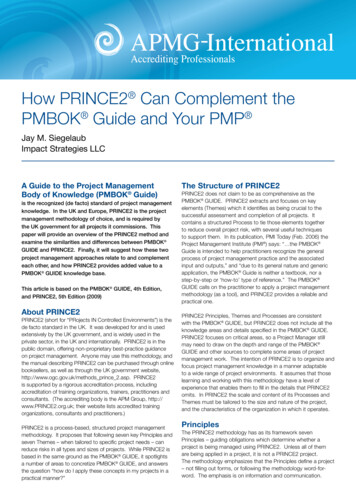
![Managing successful projects with PRINCE2 [PDF] 6th ed.,](/img/18/1-principles.jpg)
